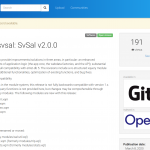The idea: automatic depositing the project’s TEI files at Zenodo
[Update 2023-01-25: There is a recording of an e-editiones workshop. However, the TEI2Zenodo platform mentioned in the article and in the workshop is unfortunately no longer reliably available.]
We have been using the github-zenodo integration for a while already with our source code releases. This allows us to deposit our code, update the deposit with new releases and get a persistent identifier for each of the versions. Since we are facing similar requirements for our TEI XML files, I have investigated how we could take profit of this or a similar mechanism. The crucial difference is this: The integration as it is makes deposits from releases/snapshots of the whole github repository, i.e. of all the files that are in the version control system. This is good for software, where all the files depend on each other and make sense only in the context of an encompassing application. But for our TEI sources, it would be better to have deposits for individual files (and persistent identifiers for them) rather than for the collection as a whole.
So I have developed a «TEI2Zenodo» service (in the following just «t2z») that can take care of uploading our files to zenodo. The idea is that a project or an institution that regularly wants to commit TEI XML files to long-term archival can host an instance of it and do its uploads via this instance. I have used it to upload 16 of our source TEI files automatically from our github repository.
